Computational Glioscience: Springer Series in Computational Neuroscience
Editat de Maurizio De Pittà, Hugues Berryen Limba Engleză Hardback – 31 ian 2019
Din seria Springer Series in Computational Neuroscience
-
 Preț: 386.39 lei
Preț: 386.39 lei - 18%
 Preț: 954.62 lei
Preț: 954.62 lei - 24%
 Preț: 1173.18 lei
Preț: 1173.18 lei - 23%
 Preț: 1342.27 lei
Preț: 1342.27 lei - 18%
 Preț: 957.13 lei
Preț: 957.13 lei - 5%
 Preț: 1424.89 lei
Preț: 1424.89 lei - 18%
 Preț: 1219.63 lei
Preț: 1219.63 lei - 18%
 Preț: 961.72 lei
Preț: 961.72 lei - 15%
 Preț: 650.04 lei
Preț: 650.04 lei - 15%
 Preț: 648.56 lei
Preț: 648.56 lei - 18%
 Preț: 1379.21 lei
Preț: 1379.21 lei - 18%
 Preț: 951.77 lei
Preț: 951.77 lei - 18%
 Preț: 1217.75 lei
Preț: 1217.75 lei - 5%
 Preț: 1411.90 lei
Preț: 1411.90 lei - 18%
 Preț: 1228.29 lei
Preț: 1228.29 lei - 18%
 Preț: 1224.68 lei
Preț: 1224.68 lei - 18%
 Preț: 1224.85 lei
Preț: 1224.85 lei - 18%
 Preț: 949.73 lei
Preț: 949.73 lei
Preț: 1124.78 lei
Preț vechi: 1371.68 lei
-18% Nou
Puncte Express: 1687
Preț estimativ în valută:
215.25€ • 233.73$ • 180.81£
215.25€ • 233.73$ • 180.81£
Carte tipărită la comandă
Livrare economică 22 aprilie-06 mai
Preluare comenzi: 021 569.72.76
Specificații
ISBN-13: 9783030008154
ISBN-10: 3030008150
Pagini: 460
Ilustrații: XV, 505 p. 205 illus., 76 illus. in color.
Dimensiuni: 155 x 235 mm
Greutate: 0.9 kg
Ediția:1st ed. 2019
Editura: Springer International Publishing
Colecția Springer
Seria Springer Series in Computational Neuroscience
Locul publicării:Cham, Switzerland
ISBN-10: 3030008150
Pagini: 460
Ilustrații: XV, 505 p. 205 illus., 76 illus. in color.
Dimensiuni: 155 x 235 mm
Greutate: 0.9 kg
Ediția:1st ed. 2019
Editura: Springer International Publishing
Colecția Springer
Seria Springer Series in Computational Neuroscience
Locul publicării:Cham, Switzerland
Cuprins
Part 1. Introduction.- A Neuron-Glial perspective for computational neuroscience.- Part 2. Calcium dynamics.- Data-driven modelling of the inositol trisphosphate receptor and its role in calcium induced calcium release.- Intracellular calcium dynamics: biophysical and simplified models.- Modeling of stochastic Ca2+ signals.- G protein-coupled receptor-mediated astrocytic Ca2+ signaling in astrocytes.- Emergence of regular and complex calcium oscillations by inositol 1,4,5-trisphosphate signaling in astrocytes.- Astrocyte networks and intercellular calcium propagation.- Part 3. Tripartite Synapse and regulation of network activity.- Tripartite synapses and regulation of synaptic plasticity.- Purinergic signaling at tripartite synapses.- Gliotransmitter exocytosis and its consequences on synaptic transmission.- Computational models of pathophysiological glial activation in CNS disorders.- Part 4. Homeostasis and Metabolic coupling.- The role of astrocytes in neurotransmitter uptake and brain metabolism.- Glutamate uptake.- Astrocytic ion dynamics: Implications for potassium buffering and liquid flow.- Constraint-Based Modeling of Metabolic Interactions in and between Astrocytes and Neurons.- Part 5. Computational Tools to Analyze and Model Astrocyte Experiments.- Computational models of astrocytes and astrocyte-neuron interactions: Characterization, reproducibility, and future perspectives.- GECIquant: semi-automated detection and quantification of astrocyte intracellular Ca2+ signals monitored with GCaMP6f.- Modeling neuron-glia interactions with the Brian 2.0 simulator.
Textul de pe ultima copertă
Over the last two decades, the recognition that astrocytes - the predominant type of cortical glial cells - could sense neighboring neuronal activity and release neuroactive agents, has been instrumental in the uncovering of many roles that these cells could play in brain processing and the storage of information. These findings initiated a conceptual revolution that leads to rethinking how brain communication works since they imply that information travels and is processed not just in the neuronal circuitry but in an expanded neuron-glial network. On the other hand the physiological need for astrocyte signaling in brain information processing and the modes of action of these cells in computational tasks remain largely undefined. This is due, to a large extent, both to the lack of conclusive experimental evidence, and to a substantial lack of a theoretical framework to address modeling and characterization of the many possible astrocyte functions. This book that we propose aims at filling this gap, providing the first systematic computational approach to the complex, wide subject of neuron-glia interactions. The organization of the book is unique insofar as it considers a selection of “hot topics” in glia research that ideally brings together both the novelty of the recent experimental findings in the field and the modelling challenge that they bear. A chapter written by experimentalists, possibly in collaboration with theoreticians, will introduce each topic. The aim of this chapter, that we foresee less technical in its style than in conventional reviews, will be to provide a review as clear as possible, of what is “established” and what remains speculative (i.e. the open questions). Each topic will then be presented in its possible different aspects, by 2-3 chapters by theoreticians. These chapters will be edited in order to provide a “priming” reference for modeling neuron-glia interactions, suitable both for the graduate student and the professional researcher.
Caracteristici
The first systematic computational approach to neuron-glia interactions Presents a "conversation" between experimentalists and theoreticians Explores a series of hot topics in glia research
